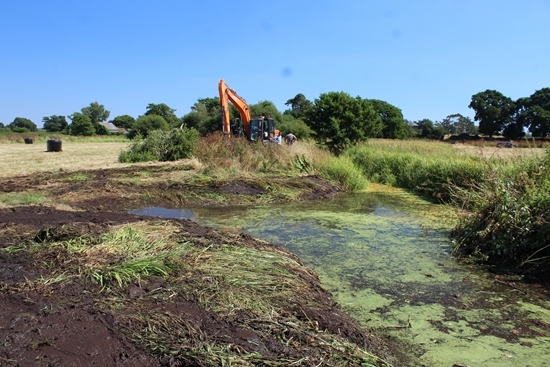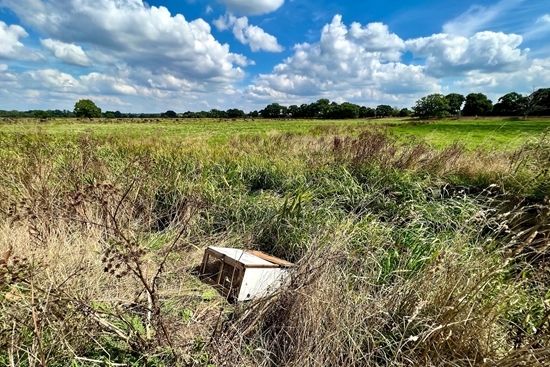Immortalised by Kenneth Grahame as poetic dreamer Ratty in The Wind in the Willows, the native water vole (Arvicola amphibius) is today a rare sight in Britain’s countryside. Habitat loss and predation have diminished the population of Britain’s largest vole by over 90%, and they are currently believed to be extinct in 97% of their former range. So, witnessing an attempt to re-establish a population in the lower Avon Valley on the Hampshire-Dorset border recently was a rare privilege indeed.
They may be a less glamorous or emotive candidate for re-introduction than the white-tailed eagle, wild boar or Eurasian beaver, but seeing three of the 48 captive-bred individuals confidently taking to the water the instant their cage door was opened, was no less moving.
And, contrary to some narratives, this release shows that not all species reintroductions require re-wilding of the landscape or designation as nature reserves. In fact, in this case, active management of habitat and predation on privately owned land will be an essential component of the new population’s success.
Creating a haven for water voles and waders
In 2021, the GWCT’s Advisory team was asked by the Environment Agency to undertake a water vole survey on the River Avon in Salisbury, ahead of the Salisbury River Park flood defence and regeneration scheme. Although the scheme will bring habitat improvements in the long term, the physical disturbance to the river during construction would negatively impact the water voles. As a protected species under the Wildlife and Countryside Act, any water vole population would need to be removed from harm’s way and relocated under a special licence.
Our team found a small population living right in the city, surprisingly quite at home in concrete-lined stretches of the river. Water voles do not displace easily and will attempt to return to their original territory, so work began on finding them a suitable new home. At the suggestion of the GWCT’s Mike Short (Head of Predation Research) and with the agreement of the landowner, the Bisterne Estate on the River Avon south of Ringwood was earmarked.

Both Mike and GWCT Wetlands Ecologist Lizzie Grayshon have worked extensively with the estate through the Waders for Real project, and Lizzie is also facilitator for the Avon Valley Farmer Cluster. Estate gamekeeper Rupert Brewer’s remarkable conservation work and skilfully targeted predation management, featured in our ‘Working Conservationists’ series, has made Bisterne a rare haven for breeding wading birds such as lapwing and redshank. Sadly, though, water voles were all but extinct on this part of the Avon.
Water voles are preyed upon by a wide range of native predators but are particularly vulnerable to the introduced North American mink (Neovison vison). Britain’s wild American mink population was already established by the 1990s when, notoriously, thousands of American mink were released from a fur farm in Ringwood, giving numbers in the Avon Valley an unwelcome boost. A generalist predator, the American mink will damage a range of protected species and, in wetlands, mink predation alone can retard water vole populations by up to 60%.
Mike Short has advised the estate on mink control and says it is “imperative if the water vole’s long-term survival is to be secured”. Using the GWCT-developed mink raft, Rupert has succeeded in largely ridding the Bisterne Estate of this pernicious predator. Combined with a programme of habitat improvements, it has made the estate the ideal home for this population.
The Salisbury River Park project funding allowed Lizzie and Rupert to carry out habitat improvements on the water meadows ahead of the relocation. Willow was cleared from the ancient herringbone system of drainage ditches, aiding waterflow and encouraging wetland plants such as reeds, rushes and sedges to thrive and provide the new water vole population with vital food and shelter. Carefully timed grazing by cattle will keep the vegetation low enough to suit both the waders and the water voles.
“The really good news,” says Lizzie, “is that these improvements will benefit a whole range of other water meadow species in the Avon Valley, including invertebrates and threatened wading birds.”

Earlier this year, the Salisbury water voles were introduced to their new country residence. At just 12 individuals the population was too small to be viable, so a further 48 water voles have been captive bred for release at Bisterne. All but three of these were given a ‘soft release’ – placed in release boxes on site to allow them to acclimatise, then checked and fed daily for 4-5 days, before being fully released into the habitat. They will be followed by another 50 next year, to try to ensure a sustainable population.
This reintroduction came about due to a publicly funded city centre improvement project, but their long-term survival depends upon privately owned and managed land, where the landowner has an outstanding commitment to managing the land for biodiversity. Under Rupert Brewer’s careful stewardship, and as one of the ‘priority species’ chosen by the members of the Avon Valley Farmer Cluster, the future looks bright for the Avon Valley’s newest residents.